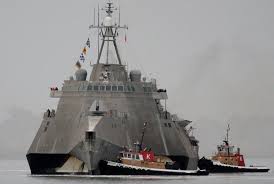 Just a quick note that erstwhile freelancer Kyle Mizokami reached out to talk LCS testing, and the result was this:
Just a quick note that erstwhile freelancer Kyle Mizokami reached out to talk LCS testing, and the result was this:
“Combat tests help remind us that in battle, winning isn’t everything; it’s the only thing,” Dr. Craig Hooper, Senior Analyst at Gryphon Scientific and blogger at NextNavy.com told Popular Mechanics. “Many ships fail their first operational tests, and struggle to make new sensors, weapons, combat systems, and crews work as a cohesive unit.”
The Littoral Combat Ship program has been trimmed from 52 ships to 40, in large part due to technical problems with the ship. Regardless of the eventual fate of the program, the U.S. Navy must get littoral combat right.
“There are no second chances in combat,” Dr. Hooper warns.
 Now, as followers of this blog know, I’m no fan of DOT&E. In short, the office has gotten far too powerful, and it loves to play politics (the constant well-timed stream of LCS leaks to Bloomberg’s LCS-hating Tony Cappacio is one example). My sense is that some in DOT&E believe the office is a shadow Department of Defense and that J. Michael Gilmore is essentially a shadow Defense Secretary. And for platforms that are systems-of-systems (with each separate system marching down their own testing plan), the testing process is a teeth-grinding exercise in exasperating testing purgatory. And God help you if your program isn’t popular–DOT&E will pull no punches for a poor program manager.
Now, as followers of this blog know, I’m no fan of DOT&E. In short, the office has gotten far too powerful, and it loves to play politics (the constant well-timed stream of LCS leaks to Bloomberg’s LCS-hating Tony Cappacio is one example). My sense is that some in DOT&E believe the office is a shadow Department of Defense and that J. Michael Gilmore is essentially a shadow Defense Secretary. And for platforms that are systems-of-systems (with each separate system marching down their own testing plan), the testing process is a teeth-grinding exercise in exasperating testing purgatory. And God help you if your program isn’t popular–DOT&E will pull no punches for a poor program manager.
It’s all a far more messy process than it needs to be. My sense is that the Testing Process is so daunting it strangles innovation–and keeps marginal platforms in production far longer than they should be. Just watch the ship classes that have made it through the testing process–each new hull gets delivered, and then they’re quietly whisked off to a different shipyard that, more often than not, adds a whole bunch of critical untested mods. Good Navy folks are doing rhetorical gymnastics to operate within the confines of a tested program of record. Given the current testing environment, the fielding of new, untested stuff is often too hard and too risky to even try. Testing is great, but…something is wrong when testing is too daunting and too biased for innovators to risk.
But DOT&E isn’t all bad
In the LCS trial–testing LCS efficacy against a small set of drone combatants–DOT&E conducted a fairly straightforward, relatively simple operational test. And the results were not good. Now…we can bicker over the details–yes, there were no missiles, and the MH-60R was apparently absent (and is, itself, still marching through tests too). But there were plenty of other troubling issues that strongly suggest the ship really wasn’t ready.
The test–along with others–did not reflect well upon the LCS Program. Follow the link and read up.
The issues that were identified must be fixed. LCS 4 will be deployed pretty soon, and that ship needs to be ready to fight. The idea that the 57mm is causing shock problems years after LCS 4 commissioning suggests that the 57mm gun should have been fired far more than it has been–if that gun is still brining cables down and breaking combat-critical systems while firing, there’s a problem someplace.
In conclusion, DOT&E testing is, for all parties, annoying and often excessive. But their combat tests–or “operational test events”–are often pretty solid tests of operational efficacy. The Navy should accept the LCS test results and really hustle to keep the reported testing failures from happening a second time.
